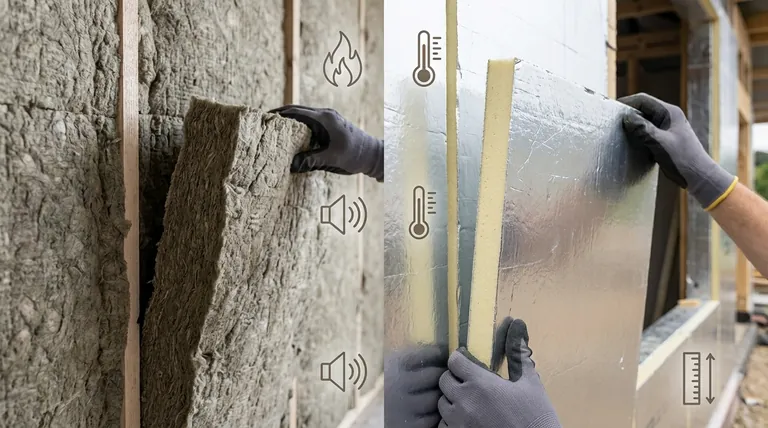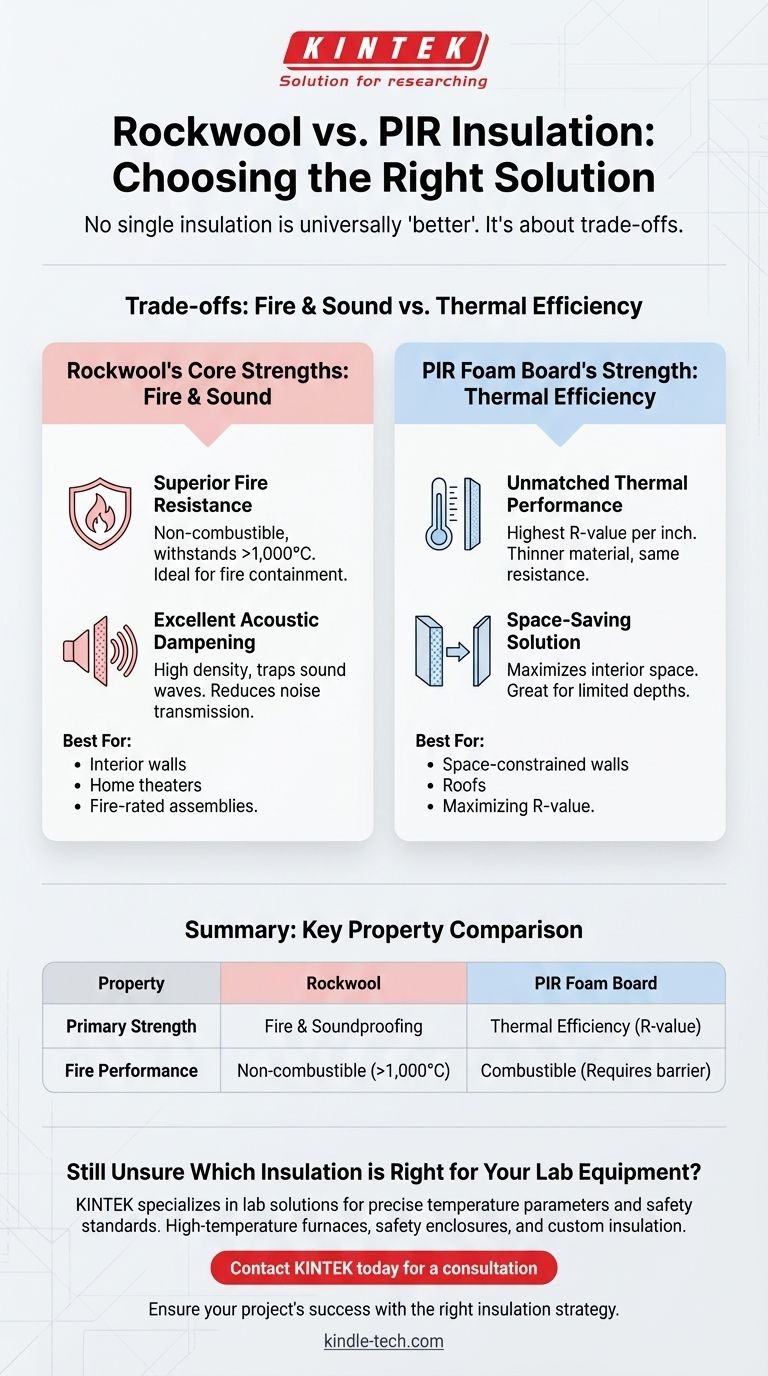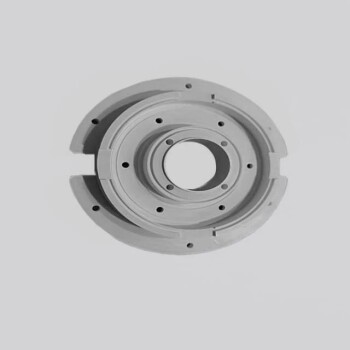No single insulation is universally "better" than Rockwool. The best choice is a matter of trade-offs, where the superior material is dictated entirely by your project's primary goal. While Rockwool is a leader in fire resistance and soundproofing, alternatives like Polyisocyanurate (PIR) foam boards offer significantly higher thermal performance for their thickness.
The question isn't which insulation is best, but which properties are most critical for your specific application. The decision boils down to a fundamental choice: maximizing fire safety and acoustic performance with Rockwool, or maximizing thermal efficiency in a limited space with a foam-based alternative like PIR.

Rockwool's Core Strengths: Where It Excels
To understand what is "better," we must first establish the baseline. Rockwool, a type of mineral wool, is an outstanding performer in specific categories due to its unique physical properties.
Superior Fire Resistance
Rockwool is manufactured by melting basalt rock and spinning it into fibers. This means it is inherently non-combustible and can withstand temperatures exceeding 1,000°C (1,800°F).
This makes it an exceptional choice for applications where fire containment is a critical safety requirement, such as in party walls, around electrical boxes, and in commercial buildings.
Excellent Acoustic Dampening
The high density and non-directional fiber structure of Rockwool are extremely effective at trapping sound waves. It absorbs acoustic energy, significantly reducing noise transmission between rooms or from the outside.
For projects like home theaters, bedrooms adjacent to living areas, or offices, Rockwool's soundproofing capability is a significant advantage.
When an Alternative Outperforms Rockwool
While Rockwool's safety and acoustic features are top-tier, its primary weakness is a lower thermal resistance (R-value) per inch compared to rigid foam insulations.
The Primary Contender: PIR Foam Board
Polyisocyanurate (PIR) is a rigid thermoset plastic foam board. It represents a different class of insulation focused on a single goal: maximum thermal efficiency.
Unmatched Thermal Performance for its Thickness
PIR insulation has one of the highest R-values per inch of any commonly available insulation material. A PIR board can provide the same thermal resistance as a much thicker Rockwool batt.
This is the critical factor when space is at a premium.
The Benefit of Space-Saving
If you are insulating walls and want to maximize interior living space, or insulating a roof assembly where you have limited rafter depth, PIR is the superior technical choice. You can achieve high insulation values without building exceptionally thick walls or roofs.
Understanding the Trade-offs
Choosing an insulation material is never about a single metric. You must weigh the pros and cons of each option for your specific build.
Thermal Efficiency vs. Fire Safety
This is the most significant trade-off. While PIR offers exceptional thermal performance, it is a combustible plastic. Though treated with fire retardants, it will burn and release smoke in a fire, whereas Rockwool will not.
For this reason, building codes often have specific requirements for covering foam insulation with a thermal barrier like drywall.
Soundproofing Considerations
The lightweight, closed-cell structure of PIR that makes it a great thermal insulator also makes it a poor sound blocker. Sound waves tend to pass through it with little resistance.
If acoustic control is a priority, Rockwool is the clear winner. Using PIR may require adding other materials or systems to achieve the desired level of soundproofing.
Making the Right Choice for Your Goal
Ultimately, the better material is the one that solves your most important problem. Base your decision on the primary objective of your project.
- If your primary focus is fire safety and soundproofing: Rockwool is almost always the superior choice, especially for interior walls, floors, and fire-rated assemblies.
- If your primary focus is maximizing thermal value (R-value) in a limited space: PIR or other rigid foam boards are the undisputed technical winners.
- If you are insulating a home studio or theater: Rockwool's acoustic dampening properties make it the ideal solution to control sound.
- If you are retrofitting an old home with solid walls or have shallow framing: The space-saving thermal efficiency of PIR allows you to achieve modern insulation standards.
Understanding these core differences empowers you to select the right material for the right job, ensuring your project's success.
Summary Table:
| Property | Rockwool | PIR Foam Board |
|---|---|---|
| Primary Strength | Fire Resistance & Soundproofing | Thermal Efficiency (R-value/inch) |
| Fire Performance | Non-combustible (>1,000°C) | Combustible (requires thermal barrier) |
| Best For | Interior walls, home theaters, fire safety | Space-constrained walls, roofs, maximizing R-value |
Still Unsure Which Insulation is Right for Your Lab Equipment?
The thermal management and safety of your laboratory are critical. KINTEK specializes in providing solutions that ensure your lab equipment operates within precise temperature parameters and meets the highest safety standards. Whether you need high-temperature furnaces, safety enclosures, or custom insulation solutions, our expertise can help you optimize performance and safety.
Let our experts help you select the perfect material for your specific application. Contact KINTEK today for a consultation and ensure your project's success with the right insulation strategy.
Visual Guide

Related Products
- Zirconia Ceramic Gasket Insulating Engineering Advanced Fine Ceramics
- Warm Isostatic Press for Solid State Battery Research
- Electric Rotary Kiln Continuous Working Small Rotary Furnace Heating Pyrolysis Plant
- High Performance Laboratory Stirrers for Diverse Applications
- Custom PTFE Teflon Parts Manufacturer for PTFE Tweezers
People Also Ask
- What material is used for furnace insulation? Key Materials for Maximum Efficiency & Performance
- What is a ceramic fiber module? A High-Temperature Insulation System for Rapid Furnace Lining
- What are the disadvantages of ceramic fiber? Key Handling & Durability Risks Explained
- What is the difference between PPF and coating? Armor vs. Slick Shell for Your Car
- What are the applications of zirconia ceramics? Unlock High-Performance Solutions for Extreme Environments



















